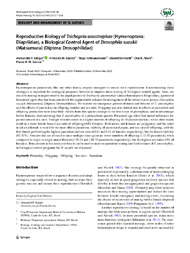Reproductive Biology of Trichopria anastrephae (Hymenoptera: Diapriidae), a Biological Control Agent of Drosophila suzukii (Matsumura) (Diptera: Drosophilidae).
Reproductive Biology of Trichopria anastrephae (Hymenoptera: Diapriidae), a Biological Control Agent of Drosophila suzukii (Matsumura) (Diptera: Drosophilidae).
Author(s): KRÜGER, A. P.; GARCEZ, A. M.; SCHEUNEMANN, T.; BERNARDI, D.; NAVA, D. E.; GARCIA, F. R. M.
Summary: Abstract: Hymenopteran parasitoids, like any other insect, employ strategies to ensure their reproduction. Understanding these strategies is important for ecological purposes, but also to improve mass rearing of biological control agents. Here, we describe mating strategies used by the pupal parasitoid Trichopria anastrephae Lima (Hymenoptera: Diapriidae), a potential biocontrol agent, that has been considered for augmentative releases for management of the invasive pest species Drosophila suzukii (Matsumura) (Diptera: Drosophilidae). We studied the emergence pattern of males and females of T. anastrephae and the efects of parental ae on ofspring number and sex ratio. Polygamy was also studied and its efects on parasitism and ofspring production were described. Adults from this species emerge in the frst hours of photophase, and males emerge before females, demonstrating that T. anastrephae is a protandrous species. Parasitoid age when frst mated infuences the parasitism and sex ratio. Younger females result in a higher number of ofspring (8.16 parasitoids/day), while older males result in a more female-biased sex ratio of ofspring (64% females). Both males and females are polygamic, and the order in which a female is mated by the male afects parasitism, viability of parasitized pupae, and sex ratio of ofspring, with the frst female performing the highest parasitism and sex ratio (63.83 and 61% of females, respectively), but the lowest viability (92.92%). Females that are allowed to mate multiple times generate lower numbers of ofspring (113.05 parasitoids) when compared to virgin or single-mated females (135.20 and 130.70 parasitoids, respectively), but the highest sex ratio (49% of females). Data present in this study and how it can be used to improve parasitoid rearing and feld releases of T. anastrephae, in biological control programs for D. suzukii are discussed.
Publication year: 2024
Types of publication: Journal article
Keywords: Biologia reprodutiva, Controle Biológico, Offspring, Parasitism, Parasitismo, Polygamy, Protandria, Protandry, Sex ratio
Observation
Some of Embrapa's publications are published as ePub files. To read them, use or download one of the following free software options to your computer or mobile device. Android: Google Play Books; IOS: iBooks; Windows and Linux: Calibre.
Access other publications
Access the Agricultural Research Database (BDPA) to consult Embrapa's full library collection and records.
Visit Embrapa Bookstore to purchase books and other publications sold by Embrapa.

